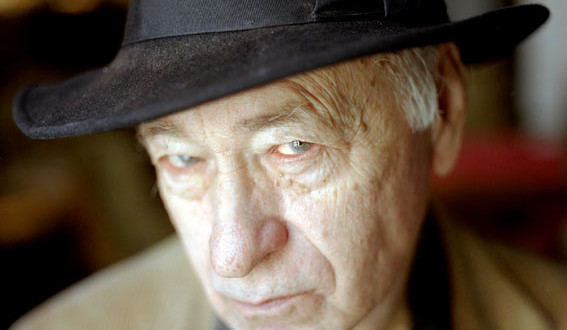By Tom Gregg

Webster’s defines Bohemian as a person, often a poet or artist, with an unconventional lifestyle. World War II Lithuanian refugee and longtime filmmaker and poet Jonas Mekas has consistently qualified.
HE BEATNIKS were the hippies of America’s 1950s. If you remember the era, you certainly remember them. You picture mop-topped young adults with goatees, wearing turtleneck sweaters, blue jeans and sandals. They read original free verse or play their own flute music in smoky coffee shops in New York City’s Greenwich Village, or screen their independently produced movies in shabby studio apartments for a handful of friends, or show non-representational art in equally shabby storefront galleries.
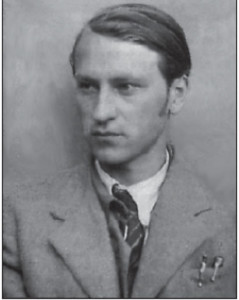
Actually, the goatee and sandals “Beatnik look” is a myth; these were, after all, creative people who valued self-expression above most everything. They weren’t into uniforms. But an image depicting the shabbiness of the Beatnik scene is accurate enough; their other guiding principle was an aversion to stooping to commercialize one’s art, and generally the Beats were faithful to their purifying principle of poverty. Faithful, or in some cases incapable of creating anything truly marketable. Whichever, their names are primarily forgotten today, with some notable exceptions. Warhol. Kerouac. Ginsberg. And probably the most versatile of them all, filmmaker/poet/writer/critic/impresario Jonas Mekas.
Individualistic as they aimed to be, the New York Beats were predominately young, educated, and from middle class American homes. Mekas, in contrast, didn’t have to develop his own art colony persona; fate handed him one. A decade older than most of his cohorts in lower Manhattan, he had been born in 1922 the fifth of six children of a farming couple in Semeniškiai, a tiny Lithuanian village near the Latvian border. He’d spent a good deal of his youth tending cows. Becoming a displaced person during WW II, he would emigrate to the U.S. and New York in 1949.
Later he, his supporters, and his critics alike would all make much of his nostalgia for his native land, and credit the depth of that emotion with fueling his sensitivity and influencing his films and poetry. An implication here is that somehow he would have been more in sync back home than in vast and impersonal New York. In fact, Jonas was a born outsider. Reared a Protestant in a devoutly Roman Catholic country, Mekas was sickly as a preteen and consequently disposed to reading. Highly intelligent, he went through the challenging book collections of his oldest brother, several literate people in the region, and finally his minister uncle in Biržai twenty miles away. He further devoted significant amounts of his boyhood time trying his hand at poetry and teaching himself to play two musical instruments. None of this activity, of course, was geared to make him more socially approachable to his hundred or so fellow villagers.
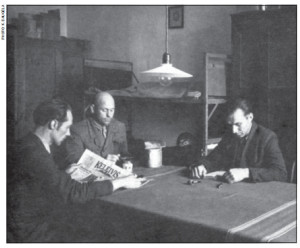
He was obviously meant for better things in bigger places, and he headed for Biržai in 1938. With a population of 5000, some signs of culture, and a high school and his uncle’s parsonage nearby, Biržai presented a chance to advance. Making the most of the opportunity, Jonas was selected outstanding student of his graduating class, toured with the local choir, started a drama theatre in town, and worked for Biržai’s weekly newspaper.
Any graduate would love to be able to list that sort of material on applications when hunting for their first fulltime job. But it was something that Mekas kept quiet at the time which would trigger his further travels. Nazi Germany controlled Lithuania in the latter half of Mekas’ six year stay in Biržai, and by 1943 he had joined a group publishing a mimeographed anti-Nazi underground paper. Output from a wellused typewriter is as unique as a fingerprint, and the Nazi secret police were looking hard for the unit responsible for Jonas’ paper. Hidden in a woodpile in his uncle’s barn when Jonas wasn’t producing another issue, the machine suddenly disappeared one day. Had it or would it come into Gestapo hands? Rather than wait to see, Mekas and family worked up a story and ID papers for him and his eighteen year old brother Adolfas. Posing as students, the pair would make for Switzerland by rail via Germany and Austria.
With no baggage and the war’s eastern front at their heels, they set out in July 1944.
The cover story would work fine until Hamburg. There, however, they were informed that the German war effort was far better served in ways besides study, and the Mekases were consigned to a forced labor camp. It wasn’t bad as far as WW II internment camps went; the brothers did mostly light factory work for eight months. Lax security allowed them an escape attempt to Sweden through Denmark that half worked, and they spent the last two months of the war hiding out and doing odd jobs on a farm near the Danish border.
The victorious Allies opened hundreds of displaced person camps in Germany and Austria to facilitate the return of an estimated eight million uprooted by the war— POWs, slave laborers, refugees—to their homelands. That process took weeks, but for the 25% who were political refugees from Sovietcontrolled countries like Jonas, determining a direction was considerably more of a problem. As Mekas notes in a 1991 autobiography, anyone was free to move from camp to camp, but political refugees were obliged to wait—and wait some more—for visas allowing them entry to the U.S., Canada, Australia, or Brazil among others. The book’s title says it all for many eastern Europeans: “I Had Nowhere To Go.”
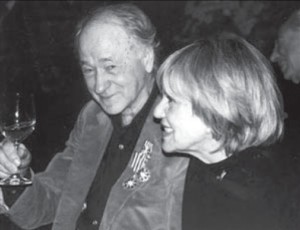
Mekas creates powerful images throughout “Nowhere,” which spans the twelve years between his aborted Switzerland run and his painful adjustment to U.S. life in the mid fifties. But he’s at his literary best describing the DP camps. Taking full advantage of the ability to circulate, Jonas and Adolfas saw a number of them in four years: typically bordering on demolished cities in dreary former worker barracks designed for several thousand, the camps featured many nationalities, long waiting lines for medical care or meager food parcels, total lack of privacy, endless card games, rampant alcohol abuse and an occasional suicide. Mekas is quick to attribute the latter two to acute homesickness for lands to which many could not return. He thinks he sees some of his own sensitivity in others; and he might have been right.
Despite the obstacles, Mekas excelled in pursuing his varied interests during his camp years; among other things, he kept the diary from which “Nowhere To Go” draws, published a volume of poetry in Lithuanian that is considered a classic today, served as culture director of one of his camps, and published a literary journal with four other Lithuanian émigrés. And although he had no way of knowing it sailing for New York in October 1949, his destination was arguably the premier place in the world in which to actively participate in any of the Arts.
Newly arrived Jonas made several decisions quickly if not instantaneously. Sensing that New York was “it,” he impetuously abandoned the original plan of moving to Chicago where an arranged job and housing awaited. Then, having seen enough movies in camp to pick filmmaking as his greatest love, he elected to concentrate on filmwork in the States. Finally, ignoring long term security, he decided to plow every spare dollar from the customary string of dead-end immigrant jobs into film and equipment. Consequently, within a year Jonas would be seen around Brooklyn’s Lithuanian section at odd hours, filming fellow DPs with a camera carried in a burlap bag to discourage thieves. Filming bits of everyday life became a long-running habit, and the visual diary would later provide grist for a number of his films.
Initially, though, there were concerns on a larger scale to attend to. Having joined a local avant-garde film society and a college night school film class, Jonas would soon discover Manhattan’s underground film world. While it had exciting potential in the early fifties, it also had problems. Mekas’ film society membership was only 3000 at the time, and word about the young media badly needed to be spread. But who wanted the job? Local artists generally frowned on “talking it up.” But being always at least a bit of an outsider, Mekas as a movie critic columnist would join a likeminded handful to publish Film Culture Magazine in early 1955.
That contact led Mekas to author a similar column running 1958- 76 for the Village Voice newspaper.
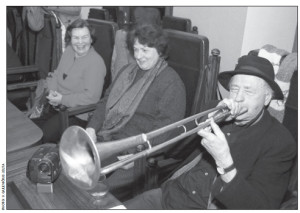
Both his columns are widely regarded as having significantly boosted New York underground film’s profile. Like many seemingly successful evangelists, however, Jonas found that while he could further a cause by publicizing it, he lacked control over the direction of growth. That was an important shortcoming for idealistic Mekas, and prompted a more hands-on approach in the 1960s. Often penniless himself, he would come to be held in awe by fellow artists during this decade for his ability to secure financing for projects he believed in: a score of small theatres, film expositions that toured Europe in ’64 and ’67, and an avant-garde film distribution center. Most of the domestic ventures expired quickly, but the Anthology Film Archives, three years in the planning before a late 1970 opening, would prove more durable. Surviving today, AFA gradually supplemented its initial offering of all-time best independent film screenings with books, correspondence, lectures, and courses. “If independent film has a home,” one critic has observed, “this is it.”
America’s fascination with avant-garde largely died with the sixties, and while underground film had gained a measure of acceptance from both Hollywood and the general public, Jonas could do little more to push it ahead. Realizing that, he shifted his focus at last to his own artistic development. He’d continue his pattern of publishing an occasional book of poetry with two offerings in the seventies, but the emphasis would remain on celluloid. By 1969 he’d begun to tap his trove of film footage dating to his early Brooklyn days, and in ten years he would build five derivative films: “Walden” (1969), “Reminiscences” (’72), “Lost, Lost, Lost” (’75), “In Between” (’78), and “Paradise Not Yet Lost” (’79).
Collectively they’re called the major Mekas Diary Films, and are his best known and most highly praised works. The praise, however, requires a qualifier. Basically collages with no story line to follow, the films can be rough going for viewers used to more structuring. On the other hand, they all exhibit to some degree an allegiance to Lithuania and therefore are worth a look. “Reminiscences” and “Lost, Lost, Lost” are of particular interest, inasmuch as each contains extensive footage of Lithuanian DPs. “Reminiscences,” equally to the ethnic point, details Mekas’ 1971 trip back to his Semeniškiai home.
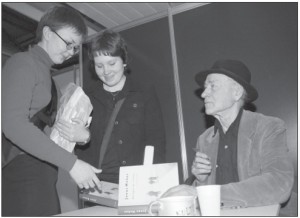
Family responsibilities helped cut his artistic output in the eighties, Jonas finally having married in 1974 and fathered a girl and boy by 1981. But he has returned to the creative forefront with vigor in the postSoviet era, producing more than twenty films. Few of the torrent of films are of Hollywood feature length not to mention content. One, however, brings the average run time up a bit: the gargantuan 288-minute “As I Was Moving Ahead, Occasionally I Saw Brief Glimpses of Beauty.” That might eventually make a great Mekas epitaph; but at least for now it’s the current installment of the Diary Films, covering everything between the wedding to photographer Hollis Melton through the film’s 2000 release.
What keeps Mekas so active approaching his eightieth birthday? Like many productive people, much of his sense of self stems from his work, which over time led to friendships with the Kennedy family, John Lennon, and Andy Warhol among others. Then too, as you look at “Brief Glimpses,” you can’t help admiring some of the locations: Vermont, New Hampshire, Cape Cod, France, Italy, Spain, and Austria. Such access—often via one film festival or another—might be hard to forgo in favor of a mainstream existence. Jonas furthermore may even be unsure what an average life IS, having been an underground fixture and having pleaded ignorance of social circumstances beyond his adopted New York. In any case, the king of Lithuanian bohemians has shown no signs of abdicating.
 DRAUGAS NEWS Lithuanian World Wide News in English
DRAUGAS NEWS Lithuanian World Wide News in English
